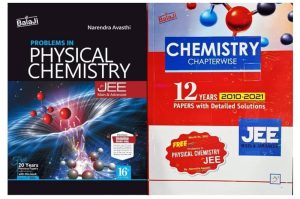Why Narendra Awasthi’s Physical Chemistry Book is a Must-Have for JEE and NEET Aspirants

Narendra Awasthi’s Problems in Physical Chemistry is widely regarded as a cornerstone resource for students preparing for competitive exams like JEE (Main & Advanced) and NEET. With over two decades of teaching experience, Awasthi, fondly known as “Sodium Sir,” has crafted a book that combines structured problem-solving with conceptual clarity, making it a favorite among engineering and medical aspirants. This blog explores why this book stands out, its unique features, and how it can help you excel in physical chemistry.
What Makes Narendra Awasthi’s Book Unique?
1. Comprehensive Problem Sets
The book is renowned for its extensive collection of problems, categorized into multiple levels of difficulty:
-
Level 1: Beginner-friendly questions to build foundational understanding.
-
Level 2: Advanced problems that mimic the complexity of JEE Advanced and NEET.
-
Level 3: Challenging questions designed for Olympiad-level preparation.
Each chapter contains 200–250 questions, ensuring thorough practice across topics like stoichiometry, thermodynamics, electrochemistry, and chemical kinetics. This tiered structure helps students progressively build confidence and tackle complex problems.
2. Concise Theory Summaries
While the book focuses heavily on problem-solving, it includes brief, well-structured theory sections at the beginning of each chapter. These summaries cover essential concepts and formulas, making it easier for students to revise quickly before diving into practice. For those seeking deeper theoretical insights, Awasthi recommends complementary texts like Peter Atkins’ Physical Chemistry, but the book’s summaries are sufficient for exam-focused preparation.
3. Free Supplementary Resources
Purchasing a genuine copy of the book often comes with additional resources, such as:
-
Previous Years’ Question Papers (PYQs): For JEE aspirants, the 17th and 18th editions include 14–15 years of PYQs with solutions, valued at Rs. 350, free of cost.
-
Mock Test Papers for NEET: The 11th edition for NEET includes 10 free mock test papers, enhancing exam readiness.
These resources, provided by Shri Balaji Publications, add significant value, making the book a cost-effective choice.
4. Trusted by Toppers
Narendra Awasthi’s teaching legacy is impressive, with over 35,000 IITians and numerous top-rankers (including AIR 1 to 10) mentored by him. His book reflects this expertise, offering problems that align with the evolving patterns of JEE and NEET exams. For instance, recent editions address the increasing emphasis on numerical and integer-type questions in JEE Advanced.
Tips for Using the Book Effectively
-
Start with Level 1: If you’re new to a topic, solve Level 1 questions to solidify your basics. Don’t skip these, as they reinforce core concepts.
-
Progress Strategically: Move to Level 2 once you’re comfortable with Level 1. Reserve Level 3 for advanced preparation or Olympiad goals.
-
Revise Regularly: Use the theory summaries for quick revisions before attempting problems.
-
Practice with PYQs: The included PYQs are invaluable for understanding exam trends and improving time management.
-
Avoid Pirated Copies: Genuine books from trusted sellers like Shri Balaji Publications or Amazon ensure you receive the free supplementary materials and high-quality printing.
Why Choose Genuine Copies?
There have been concerns about fraudulent websites selling duplicate or low-quality versions of the book. To ensure you’re getting the authentic experience:
-
Purchase from reputable platforms like shribalajibooks.com, Amazon, or Flipkart.
-
Check for the 3D holographic film on the cover, which indicates authenticity.
-
Genuine copies include free PYQs or mock tests, which are often missing in pirated versions.
Reviews from students highlight the superior paper quality and accurate content of genuine editions, with some noting that pirated copies may have missing pages or poor printing.
How It Compares to Other Books
Compared to other physical chemistry resources like P. Bahadur or RC Mukherjee, Awasthi’s book strikes a balance between accessibility and rigor. While P. Bahadur is considered tougher and sometimes Olympiad-focused, Awasthi’s problems are more aligned with JEE and NEET syllabi, with a difficulty level rated around 6/10 by students. The book’s structured approach and clear solutions make it more approachable than FIITJEE or Resonance packages for self-study.
Beyond the Book: Learning from Narendra Awasthi
Awasthi’s expertise extends beyond his book. His live classes through Vibrant Academy’s Champion Batch on Zoom offer:
-
Interactive sessions with clear explanations.
-
Animated videos to simplify complex topics.
-
Doubt-clearing sessions and personal mentorship.
-
Daily homework checks and test monitoring.
These classes, starting May 15, 2025, are ideal for students seeking guided learning alongside the book. Awasthi’s achievements as an Ironman 140.6 Triathlon finisher and Comrades Marathon runner also inspire students to stay disciplined and aim high.
Final Thoughts
Narendra Awasthi’s Problems in Physical Chemistry is more than just a book—it’s a roadmap to mastering physical chemistry for JEE and NEET. Its well-organized problems, concise theory, and supplementary resources make it an essential tool for aspirants. By combining consistent practice with genuine copies and leveraging Awasthi’s teaching resources, you can build a strong foundation and boost your exam performance. Whether you’re aiming for a top rank or simply looking to strengthen your concepts, this book is a proven ally.
Sources: Information compiled from reviews on shribalajibooks.com, Amazon, Flipkart, and Vibrant Academy’s blog.
